
Ast = Asterism; BN = Bright Nebulo; CGx = Cluster of Galaxies; DN = Dork Nebula; GC = Globular Cluster; Gx - Galaxy; OC = Open Cluster; PN = Planetary Nebula; * = Star; ♦ » = Double/Multiple Star; Vor = Variable Star

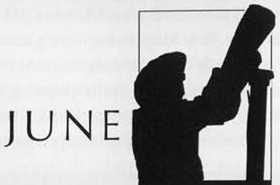
CHAPTER 6
Never setting from mid-northern latitudes, the Big Dipper endlessly circles the North Star and is arguably the most sought after star group in the heavens. For centuries it has been one of humanity's most important celestial guideposts and remains so today. Tyros of all ages turn first to it to get oriented to the sky and to determine the scale of the patterns they see on their star charts. Telescope users soon learn that the Big Dipper and its parent constellation, Ursa Major, harbor a fleet of deep-sky objects, several of which belong to the Messier catalog. Scotty has already introduced us to two of these splendors — the Dynamic Duo of M81 and M82. Now he leads us into and around the Dipper's Bowl, which abounds in deep-sky delights for beginning and advanced amateurs.
One of the nicest pieces of celestial real estate for hunting down cosmic treasures is the area around the Bowl of the Big Dipper (Figure 6.1). Aside perhaps from Orion, the Big Dipper is the sky’s best-known star pattern, with bright, easily found starting points for star-hopping to deep-sky objects. And what a wonderful selection of objects there is, for it is here in the polar region that the great stream of galaxies reaching northward from Virgo and Coma comes to a brilliant con elusion. Several bright galaxies from the Messier catalog bedeck the Dipper amid scores of others that are easy targets for 6-inch telescopes.

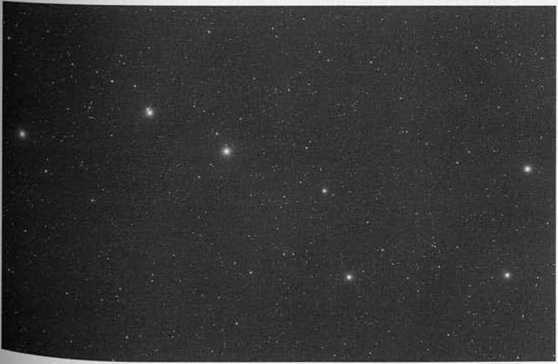
Figure 6.1
The Big Dipper is among the most familiar star patterns in the sky. Its bowl is filled with deep-sky wonders.
Unlike objects far to the south that can only be seen to advantage for an hour Or two when they cross the meridian, those in the polar sky can be profitably studied for many hours each night and for many months of the year. In late spring the flower basket of the Big Dipper’s Bowl rides nearly overhead during evening hours,
Figure 6.2 M97, the famous Owl (lower left), is a planetary nebula with two dark "eyes." Less than a degree northwest lies the remarkable spiral galaxy Ml 08, which is inclined only 8° from edge on.
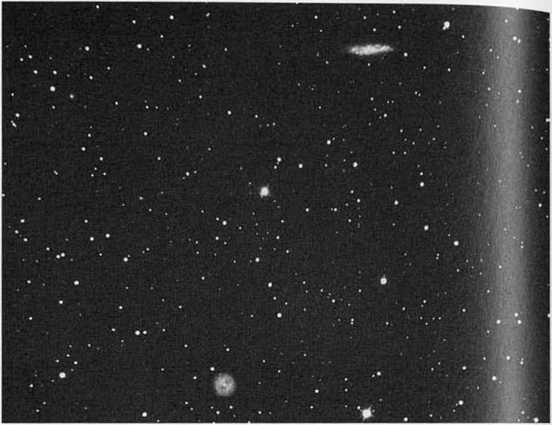
Close to thc southern edge of the Big Dipper’s Bowl is the remarkable planetary nebula M97, popularly known as the Owl (Figure 6.2). At magnitude 11.2, M97 is second only to the planetary nebula M76 in Perseus (magnitude 11.5) as the faintest object in the French comet hunter’s catalog. Nevertheless, M97 is no problem for 4-inch telescopes, and I have easily seen it in 15 x 65 binoculars. The two dark spots that form the Owl’s “eyes” are more challenging, but under good skies they might be within range of a 4-inch telescope. The nebula measures only 3', and if it is not seen at once, let your eye wander aimlessly over the field of view until the disk springs into view. Barns, in his 1001 Celestial Wonders, calls this object dull-toned, but memorable. William Herschel long ago thought it was a cluster of stars, unresolvable because of its immense distance. Even though today we know of planetaries three times farther, this object’s distance of about 10,000 light-years will make many share Herschel’s feeling of its remoteness.
Strangely enough, William H. Smyth could see nothing but a pale, uniform disk “about the size of Jupiter,” yet a 6-inch today will show something of the two dark holes in M97. But Smyth wrote before Lord Rosse found them, indicating that it is much more difficult to discover something than to confirm it. My 10' inch, under clear Kansas skies, shows the full 3' diameter of the Owl.
It’s only a short hop of 0.8° northwest from M97 to the spiral galaxy Ml08.
hich can be seen in 1 * aiming the finder a Majoris-Using their 5.
ot a faint elongated original, 18th-century make it clear he was at stuetted Messier’s worl t,e formally added to , -inht strip of a spiral
the same low-power field. Another way to find it is to start t the Dipper’s Pointer Stars, Alpha (a) and Beta (0) Ursae 4C spacing as a gauge, shift l'Zo southeast of Beta and try to streak. Although Messier did not include this object in his catalog, handwritten notes in his personal copy of the work ware of it. During the 20th century, several astronomers who c proposed that this galaxy and six others known to Messier the original list, bringing the total to 110. The galaxy is a , 8' x 2' in extent, of magnitude 10, with a faint foreground star superimposed. Herschel listed it as Number 46 in his class V (very large nebulae) and therefore Norton's Star Atlas marks it as H46\ It is easily seen in 50-mm binoculars.
photographs reveal it as an edge-on galaxy. The dim central condensation has been reported as just visible in a 3/2-inch refractor. Regardless of the telescope’s aperture, try a high magnification on this spiral. At 30x, the 12-inch Porter turret telescope showed lots of delicate internal structure. In some ways, M108 is similar to M82.1 wonder if the excessive hydrogen-alpha light known to come from M82 would cause the galaxy to appear different from M108 when both are observed through various nebula filters.
Now move to Gamma (y) Ursae Majoris, the southeastern star of the Bowl. Just !/,° southeast of this star is a 9'/’-magnitude galaxy, M109. Oval in outline and several arcminutes long, this one is bright and easy in my 5-inch Apogee telescope. Older catalogs call it only NGC 3992. Its Messier designation dates from 1953, after Owen Gingerich of Harvard Observatory discovered a previously overlooked note concerning it in Charles Messier’s personal copy of a 1784 French almanac (discussed on page 127 in “The Mystery of M102”). In my 5-inch Apogee telescope at 20x, this galaxy seems brighter than its cataloged magnitude of 10.8. I can even catch its 6' x 10' shape in 15 x 65 binoculars. I know of no amateur sightings of the galaxy’s arms or central bar, which show well on photographs. Visually NGC 3992 looks like a featureless oval glow surrounding a brighter core. There is a 13th-mag-nitude star near its northern edge. In 1956 a supernova in this galaxy reached magnitude 11.2, which was well within the grasp of amateur telescopes. This galaxy is thus a good candidate for inclusion in a visual supernova-search program.
Returning to Gamma, slew the telescope south 6° and center on 3.7-magnitude Chi (X) Ursae Majoris; then go east another 6°. In the telescope’s low-power field, there should be seen an oblong diffuse patch, the 8th-magnitude galaxy M106,just across the boundary of Ursa Major in Canes Venatici. If the night is good, you may also glimpse NGC 4217, a smaller galaxy !4° west of M106.
Bowl's Inner Sanctum
Tile Dipper’s Bowl also contains a fair number of 1 lth-magnitude and fainter galaxies which generally go unmentioned in amateur observing guides. Norton’s H°r Atlas plots seven galaxies inside the bowl, and the Skalnate Pleso Atlas of the eovens adds another five. During a visit with members of the San Jose Astronomical Association in California. 1 found that Gerry Rattley and come discoverer Don Machholz are quite familiar with these objects. As none of thc galaxies have ever been mentioned in this column before, let's take them up noxv
One of the brightest objects is the spiral galaxy NGC 3982. It is surprisin i easy to spot in my 4-inch Clark refractor, and appears as an 11.3-magnitude blu about T in diameter and slightly oval.
Another spiral, almost as bright at magnitude 11.4 and nearly twice as lar»e i NGC 3898. NGC 3610 is similar in brightness to NGC 3898 and is a tiny elliptjS cal galaxy only about 1' in diameter. My only observation of it was from Kansas in May 1956, with a 10-inch f/8.5 Newtonian reflector. NGC 3613 is a distinctly oval galaxy about IZ'long. My magnitude estimates of it average 11. And at pho-tographic magnitude 13. NGC 3683 is a difficult object. NGC 3894 is very faint while NGC 3690 is a little easier as its visual magnitude is about 12.0.
NGC 3642 is an interesting galaxy. Although its total light, equivalent to an 11.4-magnitude star, is spread over a patch some 5' across, this galaxy is not too difficult to find. Indeed, in the same 1956 observing journal in which 1 recorded NGC 3610,1 noted NGC 3642 as a beautiful sight in the 10-inch, even at 200x. I use a Barlow lens rather than a short-focal-length eyepiece for highly magnified views of deep-sky objects. The Barlow seems to add less scattered light to the field, thereby improving the contrast between the sky and galaxy or nebula. NGC 3619 is about magnitude 11.7 and T in diameter. In my 4-inch Clark it is best seen at lOOx or more. With lower powers it could be mistaken for a faint star. Slightly fainter but easier to find is NGC 3738. Still dimmer is 12th-magni-tude NGC 3756. This spiral galaxy is about 3' long and half as wide.
I have also selected five galaxies located north and east of the Bowl. All are moderately faint, but surprisingly easy in average skies. NGC 4036 is a large diffuse glow, 2.4' x 0.9' according to Sidney van den Bergh's revision of the Shapley-Ames Catalog. Some searching was needed to find it in a 5-inch richfield Apogee telescope, but once located it was readily visible as 1 Ith-magnitude, fading off at the edges. In the same field is NGC 4041. Of about the same size and brightness, these galaxies look like twins, but actually NGC 4036 is elliptical. NGC 4041 spiral.
Brightest and easiest to find in our quintet is NGC 4605. This lOth-magnitude spiral lies nearly on the extension of a line joining Gamma (y) and Delta (8) Ursae Majoris. It is obvious in 65-mm binoculars, and a large telescope makes it a fine sight, extending across a 5' x 1.2' area of sky. Equally nice is NGC 3945. an 1 lth-magnitude barred spiral. Covering an area measuring 5.2' x 2.2', it is fairly easy to find and most interesting in large telescopes.
The final galaxy. NGC 4814, is a barred spiral a little more than 2' in diameter. But do not be surprised if you should come across other objects in and around the Bowl. There are more galaxies here within reach of today’s larger amateur telescopes. Observers with 8-inch and larger telescopes will find an almost endless supply of galaxies in the area. Indeed, the Uranometria 2000.0 atlas plots 50 I within the Dipper’s Bowl. Hunting some of them down is a pleasant way to juSl d an evening under the stars.
spen
of the oldest and most unrelenting mysteries to haunt the pages of astronomical Mature is Charles Messier's enigmatic 102nd catalog entry. For many years M102 ad no proper identity — no ceep-sky object exists in the terribly rough (and bviously wrong) position provided to Messier by its discoverer, Pierre Mechain. Over the years, however, a handful of celestial detectives have challenged themselves to solve this centuries-old mystery. Some sleuthed the sky for clues. Others perused the dusty pages of old journals searching for an answer. Indeed, as Scotty explains here a major discovery in Canada finally resolved the matter. But did it? Alas, the answer is yes, but also no. Despite indisputable evidence, many amateurs to this day do not accept the Canadian discovery, opting instead to espouse and promote their own theories for the identity of M102. In the end, in the inimitable words of Scotty, "one wrong assumption coupled with immaculate logic produced a can of worms."
Amateur astronomers are a persistent lot. Give them a problem, and they can spend years chipping away at it. The late Leslie Peltier checked the star T Coronae Borealis on thousands of nights beginning in 1920. In 1866 it had briefly become a naked-eye nova, and for decades thereafter it remained a rather unremarkable lOth-magnitude object. Peltier’s vigil was an act of faith, since the star had no known history of repeated outbursts. But on February 9, 1946, the star again rose to easy naked-eye visibility at 3rd magnitude. Although Peltier wasn’t the first to note the brightening, the outburst vindicated his years of effort.
In the 1930s Joseph Meek noticed a slight, rapid cycle in the light curve of the dwarf nova SS Cygni and began wondering if the star was a close binary. It would be 20 years before spectroscopic observations at Mount Wilson Observatory proved him right.
Texas amateur Oscar Monnig had taken an early interest in photographing the spectra of meteors. Before professional astronomers turned their attention (and vastly greater resources) to this difficult task. Monnig took about half of all the "'orld’s meteor spectra.
Recent history abounds with similar stories. Most have never been written down and are preserved only in the fragile vessel of oral tradition, which has a life-SPan usually limited to that of the people who were there.
Rut the enthusiasm of amateurs sometimes leads them astray. Take, for exam-Pc- the case of M102. In 1781, Charles Messier prepared the last supplement to list of nebulae and clusters and published it in the French almanac uuaiwa/ice des temps. As in earlier installments. Messier included several Jects discovered by Mechain. These were listed as numbers 101, 102, and 103. Unlike M6chain’s previous objects, however. Messier did not observe thes three himself. Furthermore, he lacked precise positions for M102 and M103 Mechain only gave positions relative to surrounding stars.
Soon after the publication of Messier’s final supplement. Mechain wrote a |et ter that appeared in Bode’s Astronomisches Jahrbuch for 1786. In it he stated that object 102 was actually a duplicate observation of 101, but due to an error on his star chart he originally thought it was a separate nebula. At the time it Was considered no big deal — mistakes sometimes happen.
What turned this mistake into a big deal was that most astronomers remained unaware of MSchain’s letter. Later editions of Messier’s catalog failed to correct the error. Thus, M102 became one of the “missing Messier objects." As with M47. M48, and M91, its absence fascinated observers ever afterwards. Amateurs, especially. have delighted in trying to track them down, offering all sorts of explanations for why the positions in the original listing were wrong.
In his 1844 Bedford Catalogue, Smyth made a case for Ml02 being the galaxy NGC 5866. He argued that Mechain's original position for Ml02 — between lota (1) Draconis and Omicron (o) Bootis — was too vague even for a skilled observer to find it. Instead, Smyth assumed that Mechain had misread his own handwriting and the star he meant was not Omicron but Theta (0) Bootis (as you can see, omi-crons and thetas can look somewhat similar). Smyth’s “revised” position defined a much more precise location and pointed the way to NGC 5866, which is the brightest of five galaxies in the area.
Thus one wrong assumption coupled with immaculate logic produced a can of
Figure 6.3
The once mysterious 102 nd entry in Messier's famous catalog is now known to be a duplicate observation of M101, a fantastic open-faced spiral galaxy.
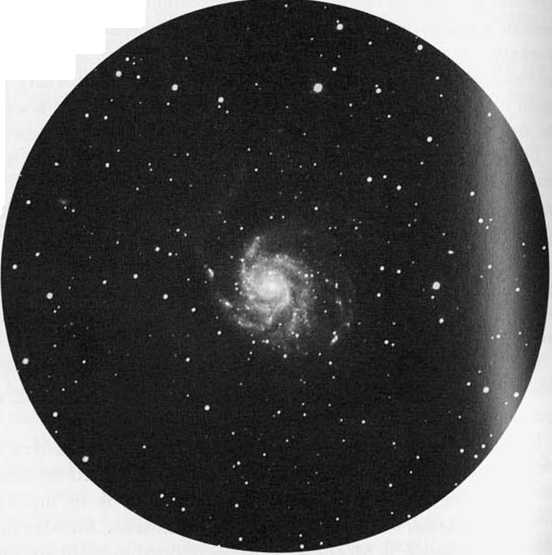
ms. Smyth was one of the most respected amateurs of all time, so you can see jjjs proposal that Ml02 was really NGC 5866 gained stature. So much so that 'vl1' the Canadian astronomer Helen Sawyer Hogg uncovered Mcchain’s letter * 1940s, her “proof’ that Ml02 does not exist met with amateur resistance.
11 whatever reason, in the hearts of many observers NGC 5866 remains as ^f.)2 even to this day. But there is little doubt that M102, as published by sier, is really just M101 repeated with the wrong position (Figure 6.3).
NGC 5866 could well have been included in Messier's catalog. Mechain proba-would have seen NGC 5866 had he happened upon it with his telescope. With maonitude of about 10.5 it is brighter than some of the catalog's other entries, and it is easily recognized in a 3-inch telescope. On excellent nights I have seen its rather narrow, 3'-long shape through the 2-inch finder of my Clark refractor.
The growing popularity of Messier clubs, however, causes the following question to be asked more often: If an amateur aims at personally observing each of Messier’s 100-odd nebulae and clusters, what should be done about M102?
The night sky is replete with deep-sky wonders. "It's difficult to imagine anyone viewing every object within reach of a 6-inch telescope," Scotty said, "not to mention a 12-inch." One problem he noticed with beginners who wrote to him was that they often wondered where to start. Should they work like bird watchers who refer to life lists and methodically check off each item? One obvious reply would be for them to start out by viewing the 109 objects on the Messier list, then graduate to the catalog compiled by William and John Herschel. Others would suggest seeking out all the objects of a particular class. Do you like globular clusters? Well, you can obtain lists of all the globulars visible to a certain magnitude limit and start checking them off. The same goes for planetaries, galaxies, and double stars. Scotty, however, was not your mainstream correspondent. If you wrote asking for advice, his response would not be trite. Scotty was keen on devising new ways to explore the heavens, and he welcomed the challenge of blazing new trails for beginners. Thus was born, for lack of any "proper Scottyism," his Deep-Sky Triangle.
r he memory of winter begins to ebb in June as mild but crisp nights complement I the celestial riches now in the sky. Arcturus shines overhead, and Corona Borealis, the Northern Crown, is at its dainty best. Draco coils in pinpoint stars about the ecliptic pole, and the great globular star cluster M13 is climbing up the eastern sky. It doesn’t matter if you use binoculars or a 20-inch telescope, there ls so much to see that you wish for an impossible succession of crystal-clear n'ghts — but where to begin?
One way to start your assault on the night sky is by selecting an area defined y several bright stars. With the aid of a good star atlas, wc can then seek out all e objects in this area. For example, this month let’s take the triangle of stars
Figure 6.4
Seeking out all the astronomical treasures within the Deep-Sky Triangle — formed by Eta (T]) Ursae Majoris, Alpha (a) Canum Venaticorum, and Gamma (y) Bootis — is a good way to start your "assault" on lune's night sky. North is to the upper left.
Figure 6.5 M51, the Whirlpool Galaxy, is popular among photographers and visual observers because its spiral structure is so easily resolved. The small companion galaxy is NGC 5195.
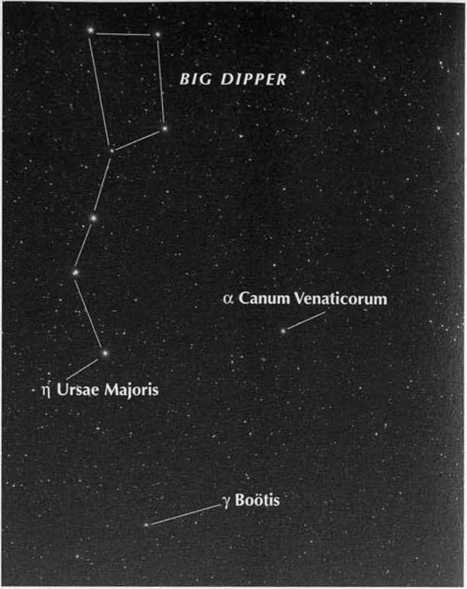
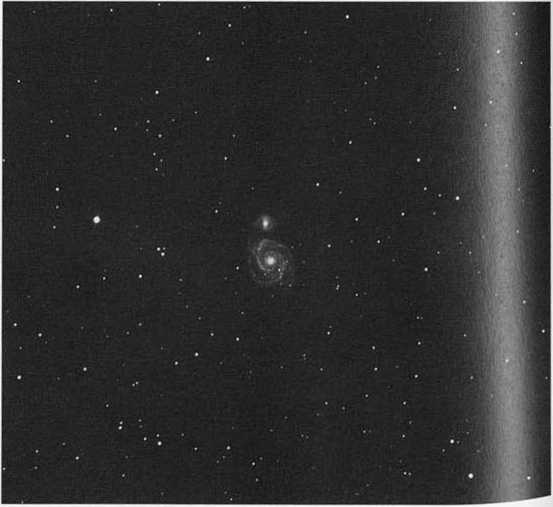

e 6.4) formed by Eta (q) Ursae Majoris. Alpha (a) Canum Venaticorum, K*Gamma (y) Bootis, found hanging on the end of thc Big Dipper’s handle. 8 lance at Tirion’s Sky Atlas 2000.0 shows that at least a dozen galaxies lie 'thin l*ie triangle. Just mside and outside its western edge, several notcwor-examples are M51, M63. and M94. which can all be seen in binoculars nder good conditions.
U This part of the sky is far front the plane of the Milky Way so, as we might expect- there are no prominent star clusters nearby. M51. the Whirlpool Galaxy ,F eure 6.5), lies just outside the triangle about a quarter of the way from Eta Ursae Majoris to Alpha Canum Venaticorum. Messier found the galaxy in October 1773, while observing a comet he had discovered. Eight years later jvlechain noted that the galaxy was double. He saw the two components as clearly separated centers with halos touching one another. Today, nearly every amateur telescope will show M51 (with its companion NGC 5195). Even through smog and thin clouds a 6-inch will reveal the two components that such 19th-century observers as Smyth and Thomas W. Webb wrote so enthusiastically about.
The Whirlpool offers challenges for any telescope. For example, what is the smallest aperture required to reveal the spiral structure? Lord Rosse first detected spiral structure when he turned his giant 72-inch reflector on the galaxy in the spring of 1845.Today, with our vision sharpened by knowledge, the spiral features of M51 are visible in instruments as small as 10 inches, and some observers have glimpsed them with 6-inch telescopes in very dark skies. An 8-inch is sufficient for me, but John Mallas needed a 12'Z-inch in a dark desert sky. He correctly noted that experience and exceptional transparency are important for success. In 1936 I had a very good view of the spiral structure using the University of Arizona's 36-inch reflector in Tucson.
In clear, dark skies, an 8-inch at 40x will show the brightest portion of M51 to be about 11' long and 8' wide. Increasing the magnification to 200x, especially when the seeing is good, may reveal considerable structure in the disk, which at first glance appears rather uniform. Observers can also try to detect the “bridge” of light that connects the two galaxies. Again. I have seen it clearly with an 8-inch, but Mallas drew it as it appeared through only a 4-inch. Yet he recalled that perhaps he knew the field too well from photographs, and his observation may have been biased. Some amateurs have followed the entire bridge using a 17.5-inch in the clear desert skies of the American southwest. I have even seen traces of it here in Connecticut. The real key to viewing it is sky transparency, Slnce the slightest moonlight or light pollution renders it invisible.
A third challenge was proposed by Ronald Morales of Tucson, who observed fr°m the Santa Rita Mountains southeast of the city. Using a 10-inch f/5.5 reflector with a 16-nim Konig eyepiece, he steadily held with direct vision a faint star suPerimposed on the southwest quadrant of M51’s disk. I wonder how small ® telescope will reveal this star. I failed to see it with a 4-inch in good skies, owever, I suspected the bridge, which apparently was not seen by Morales on the night lie noted the star. West of M51's center, and superimposed on th. galaxy’s disk, is a foreground star that is occasionally mistaken for a supernova
About !4° south of M51 is a much more difficult object, the small elliptjCaJ galaxy NGC 5198. It is round, 2' in diameter, and I estimate it as magnitude 12 '•> High magnification is useful when searching for this small object, as it can look rather starlike at low powers.
Moving southward, the bright galaxy M63 is about two-thirds of the wav from Eta Ursae Majoris to Alpha Canum Venaticorum, and as far inside the triangle as M51 is outside. Mechain discovered it in 1779 (Figure 6.6). At magnitude 8 6 it is apparent in any telescope, and I have seen it well in a 2-inch refractor. On another occasion, while using a 29-inch, I caught sight of the faint spiral arms surrounding M63’s bright core.
Figure 6.6 M63 is a rare type of galaxy whose many spiral arms bear a rash of star clouds. Its dappled appearance gave rise to its nickname, the Sunflower Galaxy.
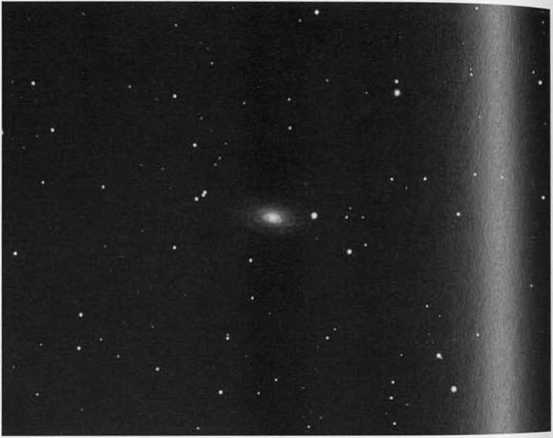
Alpha Canum Venaticorum is popularly named Cor Caroli, the heart of Charles. Legend attributes the name to Edmond Halley, who was honoring his benefactor, England’s King Charles II. There is less than solid proof of this, however, and some question remains as to whether the honor was intended for Charles I. Sweeping just over 1° southeast of Cor Caroli brings us to a pair of faint galaxies. NGC 4914, at 12th magnitude, is brighter and larger than NGC 4868. Both should be within range of an 8-inch, given a dark enough sky.
NGC 5005 is located about 1 !4° farther to the east-southeast. At magnitude 9.8 and 5' long, this slender spindle of light is better known than either NGC 4914 or NGC 4868. Look for another galaxy, NGC 5033, roughly 1° southeast of NGC 5005. It would be especially nice to observe this object with an aperture of 20 or more inches. I suspect that some internal detail is visible, though none is appar' ent in an 8-inch telescope.
pjcar the midpoint of the triangle's southern edge is a loose swarm of galax-yVc can begin with a group of three that lie in a north-south line within the lCS\e low-power field of view. Even casual sweeping of the area should turn them up. The largest (nearly 3' in diameter) is the 11.4-magnitude spiral NGC 535O It shows up clearly at 20x in my 5-inch Apogee telescope, and I once saw • at the annual Stellafane convention in Vermont with a 10-year-old girl's homemade 4-inch off-axis reflector.
Just 5' south of NGC 5350 — roughly half the distance between the famous double star Mizar and Alcor in the handle of the Big Dipper — lies a pair of galaxies almost in contact with each other. The southern one is the 11.1-magni-tude elliptical NGC 5353, which is cataloged as a bit over 2' in diameter. Just 1' to its north is NGC 5354, about the same size and perhaps half a magnitude fainter. Like NGC 5350, it is a spiral.
About Z° to the east of this triplet is the spiral NGC 5371. At magnitude 10.8 and some 4' in diameter, it should be an easy object in just about any telescope. An 8-inch telescope will show hints of internal detail, while my notes on the galaxy tell of one observer, using a 36-inch, who could sec faint arms and a prominent central bar. My 8-inch reflector shows what is cither a bright stellar nucleus or a foreground star superimposed on the galaxy's center.
NGC 5371 is the subject of an interesting and instructive tale. The galaxy was discovered by William Herschel, who called it “pretty bright, large, round, brighter middle with a faint nucleus.’’ It was also observed by his son John in May of 1831. John recorded no description of the object on this date, but during one of his sky sweeps two months earlier he “discovered” NGC 5390 located 20' east of NGC 5371. (For the sake of clarity I'm using NGC numbers, but these were actually added later. The Herschels used other designations.) John recorded the new object as “faint, large, very gradually brighter middle, with a 9th-magni-tude star to the northeast." He does not mention seeing NGC 5371 on the night he observed NGC 5390.
Today we know that there is no object at the position John gave for NGC 5390. I've even checked photographs of the area made with the Palomar 48-inch Schmidt telescope. A quick review of modern references, including Vol. 2 of Sky Catalogue 2000.0, reveals that NGC 5390 is a duplicate observation of NGC 5371, but 1 don’t know who first pointed this out.
There is little doubt that it was a duplicate observation. First, John didn’t see NGC 5371 on the night he “discovered" NGC 5390. Furthermore, the real NGC 5371 has a star just to its northeast that matches John’s description of NGC 5390. A slight error in recording the object’s position would make it seem like a discovery. But why did John call the galaxy “faint" and his father say it was “pretty bright," when both were using the same telescope with an 18.7-inch speculum-metal mirror? Perhaps the mirror’s surface was tarnished and in need of polishing °n the night John observed the galaxy.

goes to show that the descriptions in the New General Catalogue of id Clusters of Stars (NGC) are a rough approximation of what we can
expect to see in a telescope. They were never intended to be more than that 1
any case. ’ln 1
1
Aside from the "missing" Messier objects (M47, M48, and M91), the most intrigUjn aspect of Messier's catalog — one that arouses amateur interest, as Scotty believed^ — is the origin of its final seven entries. Messier's original catalog, published in installments from 1774 to 1 787, listed only 103 deep-sky objects, including one duplicate observation (M102), a double star (M40) and an asterism (M73). Indeed some observers resist the so-called "final seven" and argue that the true Messier catalog contains only 103 deep-sky objects. Earlier this century it was proposed and widely accepted that seven more objects be added to the Messier catalog for various and sundry reasons. "Of these additions," Scotty proffered, "the galaxy M106 in Canes Venatici is particularly interesting."
Charles Messier discovered a comet drifting through Ophiuchus on September 27, 1793. As he had done in the past, the French astronomer called upon his mathematician friend Jean-Baptiste-Gaspard Bochart de Saron to calculate its orbit. Readers with a bent for astronomical history may recall the unusual circumstances surrounding this event. Bochart de Saron had been imprisoned during the French Revolution’s Reign of Terror and was awaiting execution when he received word of Messier’s new comet. Nevertheless, he worked out an orbit, which Messier used to recover the comet after its conjunction with the Sun. Messier was able to slip his friend word of the success before the guillotine’s blade fell on April 20,1794.
I wonder if other aspects of the Reign of Terror have trickled down through history to affect today’s amateur astronomers. Certainly Messier’s work must have been affected during the Revolution. Had it not been, he might have caught and corrected some of the errors that appeared in his original catalog — errors that continue to fuel star-party debates as amateurs speculate on the true identity of several “missing” Messier objects.
Another aspect of Messier’s catalog that arouses amateur interest is the final seven entries. An original paper by H. S. Hogg, in which she describes five of these seven objects, and which deserves to be read by every amateur as a lesson in industry, appears in the Journal of the Royal Astronomical Society of Canada. September 1947. Of these additions, the galaxy Ml 06 in Canes Venatici is particularly interesting (Figure 6.7). Descriptions of its visual appearance vary considerably. Photographs are of little help in resolving the discrepancies since the differ' ence between them can vary almost as much. (Even prints made from the same negative will look different depending on how they are exposed and developed.)
Hans Vehrenberg’s Atlas of Deep-Sky Splendors includes a shot of M1^ made with the 200-inch Hale telescope at the Palomar Observatory, as well as a
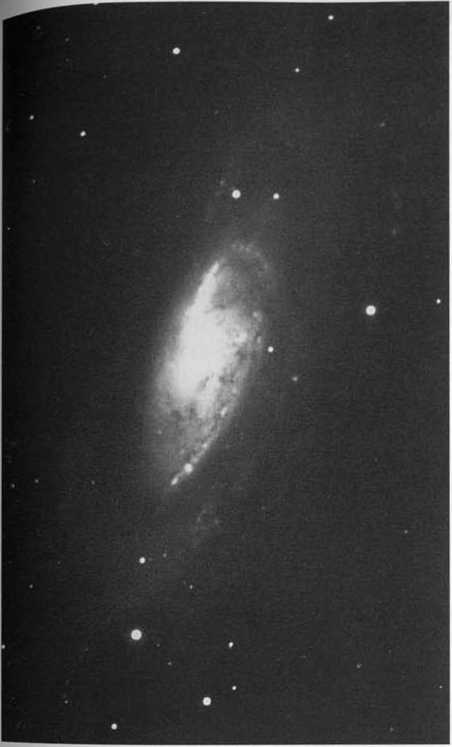
Figure 6.7
The peculiar galaxy Ml06 in Canes Venatici has had a violent past. Its arms are scarred with material blown out of the galaxy's nucleus during vast interstellar storms.
wide-field view made with a 12-inch Schmidt camera. The 200-inch photograph gives the impression of a barred spiral seen almost edgewise, but in the image made with the smaller telescope M106 looks more like a regular spiral. The truth probably lies somewhere in between, since M106 is classified as a peculiar Sb spiral in Sky Catalogue 2000.0.
Ronald Morales viewed M106 with his 10-inch Newtonian reflector. Using 87x he described it as “extremely large; very bright with a bright, compact center; extended in a north-south direction with a large, fuzzy outer envelope. Years ago in Kansas 1 viewed the galaxy with a 10-inch reflector at about the same magnification and saw a “very bright parallelogram shape with fragile spiral arms at the ends of the major axis." The nucleus appeared uniform with little variation in brightness. Other observers using 8-inch telescopes have reported Ml 06 s appearance as long and needle-like, and one saw a dark area near the aucleus. So much for consistency!
Say the words "Virgo" or "Coma Berenices" to a seasoned observer and a knowing look will come over his or her face. If there is one area of the heavens beloved by galaxy hunters and hated by comet hunters (because it's so hard to spot a comet against all the other "faint fuzzies"), it is the great Coma-Virgo cluster of galaxies "Amateurs today tend to acquire larger and larger telescopes," Scotty explained, "and the constellations of Coma Berenices and Virgo offer challenges that take us beyond merely re-observing well-known objects. Since the North Galactic Pole is nearby there is very little interstellar dust in this direction, giving observers a clear window to the universe." But tackling this region for the first time can be a daunting task. Star-hopping is an acquired skill, one best practiced in a less galaxy-polluted region of sky. Naturally, Scotty was not at a loss for a better way. Here he introduces a fun and pragmatic technique practiced in the late 1700s, but largely forgotten or avoided today (because of the necessary time commitment). There are also several underdog objects among the opulence of galaxies. For instance, Scotty reveals a neglected corridor of globular clusters in the region. Another object, the largest and brightest in this vast area of sky, is obviously itself one of the sky's most uncelebrated hidden treasures.
What open cluster is visible to the naked eye, has no Messier or NGC num
ber, and was called “gossamers spangled with dewdrops” by the 19th-cen-tury astronomy popularizer Garret P. Serviss? Almost every skygazer has seen this group at one time or another, and its official designations are Melotte 111 and Collinder 256. The answer will surprise many, for the cluster is the shimmering haze of 5th- and 6th-magnitude stars we call Coma Berenices. It is a real cluster and not just a chance alignment of stars. There are about 80 members scattered across 5° of sky. A camera with high-speed film can record the cluster with an exposure of just a few seconds. Coma Berenices is only 260 light-years away and is one of the nearest open clusters. Therefore its stars appear well separated. If they are a bit too faint for your naked eye, a simple 2x or 3x opera glass gives a wonderful view.
Of course to observers of intergalactic depths, this region of sky belongs to the great clouds of spirals that dominate Virgo, Coma Berenices, and Canes Venatici. Less realized, perhaps, is that in these same regions we get the first onrushers of the globular clusters which finally swarm in their greatest profusion around the galactic center in Scorpius/Ophiuchus/Sagittarius.Three globulars are within the narrow limits of Coma itself, including two that lie near Alpha. NGC 5024 (M53) is 14.4' in diameter with a magnitude of 8.7. Unimpressive in a 3-inch refractor, its star sprinklings are magnificent in a 12/2-inch reflector, where faint streams of curving stars run out from the central blaze in all directions. Smyth called it an “interesting ball of innumerable worlds.”
Almost in the same field is NGC 5053, diameter 8.9', magnitude 10.9. In large instruments it is a little gem of woven fairy fire. Hogg’s Bibliography oflndivid“a globular Clusters shows that it was first observed by William Herschel on March |4 1784. It is remarkable for its position in space, perhaps 50,000 light-years ,ltlOve the galactic plane.
Considerably to the west of these two lies NGC 4147, magnitude 11. Its faintness misled Herschel, on the same date as that he first observed NGC 5053, into listing >t as something external, and only with the great reflectors of the 20th century could its individual stars be seen well and studied. We now know of several variable stars in this faint object.
In the same field lies a true faint external galaxy, NGC 4153, about 13' south and about 8' east of NGC 4147. It is not listed in the Shapley-Ames Catalog, and hence must be fainter than 13th magnitude. It would be a real feat for an amateur telescope to locate it. I have examined NGC 4147 on half a dozen occasions without noticing the faint galaxy.
In the western part of Virgo, galaxies are crowded like a confusion of silver sands. But eastward from the middle of the constellation, deep-sky objects are more scattered, and amateurs may have difficulty in locating some of them because easily identifiable stars are few.
There is a strip of sky here near declination +02° where several galaxies and a beautiful globular cluster can be readily located by means of a technique that dates back to William Herschel (Figure 6.8). Thc procedure is simple: set your
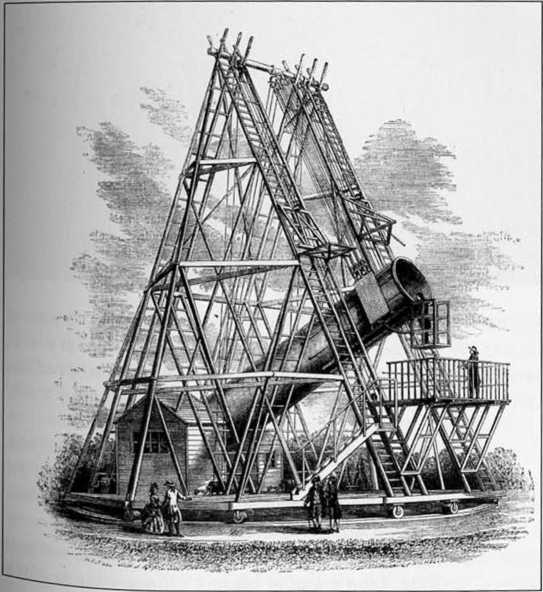
Figure 6.8
Herschel's 40-foot telescope was a veritable cosmic workhorse, which he used to plow up new deep-sky wonders.
telescope on a prearranged starting point, leave it stationary, and watch celcsf objects drift through the field according to a timetable.
For this purpose, use a low-power eyepiece with a field not much less thg I 1° across. To check the field size of an eyepiece, time the drift of an equate ■ ° star centrally across it, and count one minute of arc for every four seconds '* time. Once that’s completed select a star lying west of the desired galaxy hif having nearly the same declination. The telescope is then left stationary. allow ing diurnal motion to carry the object into the center of the field. The drift time required is the same as the difference in right ascension between the star and the galaxy.
Figure 6.9 You can find several galaxies and a globular cluster easily by letting the sky drift over your stationary telescope. Start your scan at the small galaxy NGC 5746.
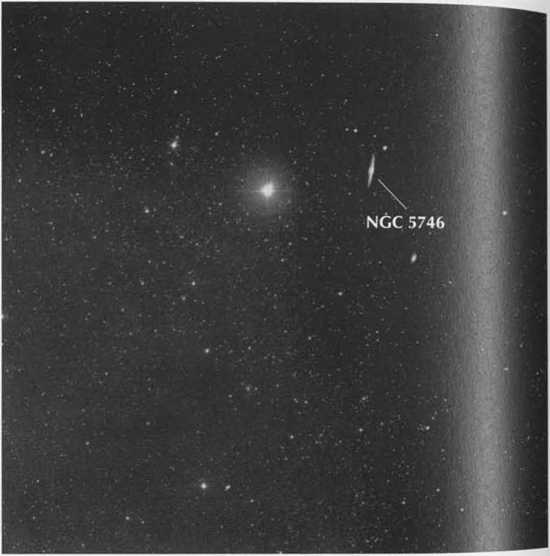
Begin by picking up the elongated spiral galaxy NGC 5746, about Z<° west of the 4th-magnitude star 109 Virginis. It is a lOth-magnitude spindle about 6' x 1. less in small telescopes. A more difficult spiral in the same field. NGC 5740, hes about !6° to the southwest of NGC 5746. It is about magnitude 12, and 2' x 1 across.
NGC 5746 is the starting point for our strip (Figure 6.9). Center it in the ticlti-clamp the instrument, and be careful not to shift it during the remainder of the experiment. Then relax and watch the stars glide by. Keep track of the time that has elapsed since the starting object was in the middle of the field.
Consult a schedule of times at which some stars and deep-sky objects will PasS the midline of the eyepiece field. After a wait of about 13 minutes, the first fl a of galaxies near 110 Virginis will appear at the edge of the field. Be care-^' "'ot to let the light of this star dazzle your eye when it comes into view about Lee minutes later.
I lic brightest of this little group is NGC 5846, a compact elliptical galaxy. IV overlapping it is a much fainter but somewhat larger companion, NGC - L On an excellent night in 1935,1 found it was easy in a 4-inch.
After another gap of about 10 minutes the great globular cluster M.S swims to view (Figure 6.10). About /s° in diameter, it is one of the better globulars

Figure 6.1(1 End your scan at MS — a stunning globular cluster — which seems to float above the stars of Serpens. In between NGC 5746 and M5 lie several faint galaxies.
for small telescopes, because it actually gives the impression of being a cluster rather than an amorphous glow.
Tlte strip method of observing is a handy way of picking up an inaccessible object without using the setting circles on your telescope. From a star atlas select an easily identifiable star having nearly the same declination to the west, and find from their differences in right ascension how long to wait. Also, the stiip technique can be used to explore rich Milky Way regions this summer. You can obtain the approximate position of any object of interest by noting how long an 'nterval of time it follows the starting star, and by estimating how far north or s°uth of the center of the field it passes. By the way, on an exceptionally good n*8ht,can you see M5 with the naked eye, just north of 5 Serpentis?
One point Scotty often repeated in his columns was that when searching for faint objects, it is beneficial, if not imperative, to have a set of star charts with a magnitude limit of at least 9. "On such charts," he said, "there will almost alwa be one or two stars that appear in the same low-power field as the object of interest. This will help not only in locating but also in identifying objects misidentifying deep-sky objects is a sin common to both novice and experienced observers alike." As a case in point, he referred to a small group of galaxies near the border between Corvus and Crater. One of them, NGC 4038 (the famous Ring-tail Galaxy), he said, deserves special attention, because "several times amateurs have sent descriptions of what they believe is this galaxy, but I'm sure they have mistaken another galaxy for the Ring-tail." The clarification seemed particularly important to Scotty because he had an affinity for this region of sky- it took him almost 60 years to learn to appreciate Crater and Corvus, and he wanted to be sure that his readers got the full benefit of their efforts as they tipped their telescope tubes toward these southern celestial wonders.
There is never a shortage of deep-sky objects. Whatever the season, the sky holds more than enough of these delights to keep you busy all night, every night — if you take the time to search them out with good charts and reference books. Many deep-sky objects have special features to tantalize you. In the June evening sky, almost every direction we look offers something interesting. But near the meridian this month are two constellations that took me almost 60 years to learn to appreciate. Corvus, the Crow, and Crater, the Cup, seem like insignificant asterisms when viewed from the United States. 1 always found them delicate, with stars that had to be picked out from the background. They are not at all like Cassiopeia, Cygnus, or Delphinus, which almost force themselves on you. My feelings changed when I first saw Corvus and Crater from Central America.
Raise the Glass to the Cup . . .
William Tyler Olcott’s classic A Field Book of the Stars first made its appearance about the time Halley’s Comet swept through the inner solar system m 1910. Olcott’s outlines of the constellations were the only ones several generations of young astronomers knew, and many of his patterns are still accepted today. I especially like Crater, the Cup, perched precariously on Hydra and tilted as if to pour a celestial libation of stardust.
As a youth, I found Crater a lucid grouping of stars that was a delight to explore with a 1-inch, 40x refractor. Today, however, my mail indicates that few amateurs pay much attention to this area of the sky. While many of the deep-sky objects here should be better known to amateurs, there are no spectacular ones to draw observers into the area. The light pollution surrounding urban centers leaves this faint constellation little admired.
ML
nurnham’s Celestial Handbook lists only 15 deep-sky objects down to magni-j, 13 in Crater. All but one are from the New General Catalogue of Nebulae tu alters of Stars.There are many fainter NGC objects in this part of the sky, fl/i -ell as a num'5er °f others listed in the two Index Catalogues. Novice 8 ervers may find all this a bit confusing. Several years ago, when a 12-inch was ° s dered a really large amateur telescope, deep-sky objects of magnitude 13 C°emed like a realistic limit for most observers. But now, with 17-inch and larg-telescopes commonplace, many fainter galaxies that are not to be found in ular observing guides are accessible to amateurs.
P A large telescope is not necessary to enjoy the pleasures of Crater, where the ity of naked-eye stars makes good charts quite necessary; it is almost always indispensable to have an atlas showing stars to at least 9th magnitude.
Figure 6.11 Despite its southerly location, the egg-shaped galaxy NGC 3887 can be spotted in a 4-inch telescope near Zeta (£) Crateris.
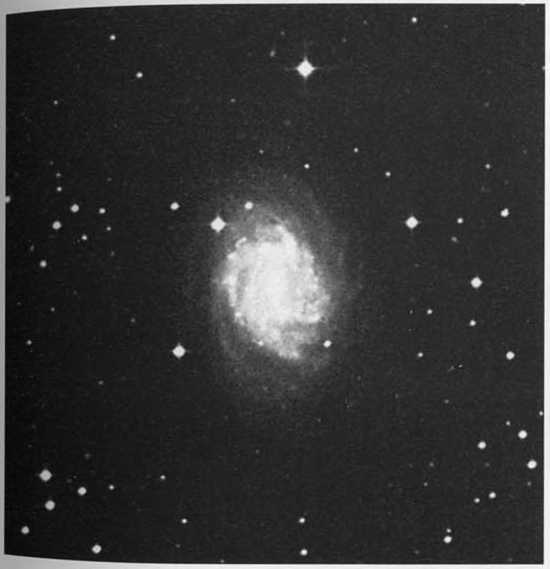
There are perhaps a score of objects within the reach of an 8-inch under good skies. NGC 3887, an 11 th-magnitude spiral galaxy (Figure 6.11) not far from 5th-magnitude Zeta (Q Crateris, was discovered by William Herschel. Its oval disk is about 2.5' long and rather easy to find in a region devoid of faint stars. In the mid-s the galaxy showed well in a 4-inch f/16 off-axis reflector. In the transparent
V Kansas, a 10-inch f/8.6 reflector at 60x revealed NGC 3887 to be quite 8 t and egg-shaped. My old notes also suggest that a trace of the spiral arms as also visible in this instrument. The galaxy is easily picked up in my 5-inch P gee telescope, but at 20x it is a blur just barely distinguishable from a star.

NGC 3672 is another spiral galaxy discovered by the senior Herschel 1( • little brighter than 12th magnitude, and some 3.5' long and half as wide. [ v: , 'S a this galaxy from Madison, Wisconsin, with the 6-inch Clark refractor that I belonged to the famous double-star observer Sherburne W. Burnham. My'm^ novice eye required 150x for the observation. One of this telescope's eyepje(,Cn was most unusual for its time; it was of l'A inches focal length, made by Jo^ Brashear, and possibly designed by Charles Hastings. It had a wide appa ” field, and gave such unmatched views of deep-sky objects that it played a nt " role in my growing interest in this branch of observing.
NGC 3637 is a tiny spiral only about 1' in diameter. With low powers this object will almost always be mistaken for a star. I suggest searching for it with a least lOOx. There is a 7th-magnitude star just 3' southwest of the galaxy. Similar in shape and difficulty is the slightly smaller elliptical galaxy NGC 3732. Again high magnifications will be a help when searching for this object.
More challenging is the faint spiral galaxy NGC 3865. It was missed by the Herschels, and, not surprisingly, I have never been able to find it with my 4-inch Clark refractor. I have seen it, however, with the 20-inch Clark at Wesleyan University. Its oval disk is about 1.5' long and of magnitude 13.5 or perhaps a bit fainter.
If you are successful in locating NGC 3865 and want to try something even more challenging, try hunting down the twin galaxies NGC 3634 and NGC 3635, which are nearly in contact with each other. They are almost stellar in appearance and around 15th magnitude. If the sky is perfectly clear and dark, they may be within the reach of a 10-inch telescope at high magnification. A 16-inch should show these galaxies well above thc visual threshold.
. . . Then Sail on to Corvus
Many amateurs living at mid-northern latitudes consider the southern constellation Corvus, the Crow, dim and uninspiring. But when I first saw it from Central America I found it far more impressive than Hercules. I often wonder why there is no indication of this star pattern in the Mayan Codex (of Mesoamerican astronomical tables); then again, maybe there is and scholars just haven't recognized it yet. Its four prominent 3rd-magnitude stars, however, do not remind me of a crow. I grew up on the shores of Lake Michigan where sailboats were part of my very essence, and I can see Corvus only as the sail of a small gaff-rigged vessel heading eastward on the back of Hydra.
The first telescopic object I usually turn to is the small but really fine planetary nebula NGC 4361, located in the north central part of the “sail ! igurc 6.12). Curiously this object was not included by Smyth in his Cycle of Celestial Objects, and William Herschel thought that it was resolvable into stars. This description is all thc more strange because even in my 4-inch refractor NGC 4361 looks like a planetary, and in a 12-inch its character is unmistakable. It is not a typ* ical planetary, however, for Lick Observatory photographs show a central nucleus with arms superficially resembling a barred spiral. If NGC 4361 were highei in |hu. northern skv. I can t help but think that it would have ended up in Messier’s .,lialog and thus be considered among the anointed by today's amateurs.
[t is wise to use at least 80x to lOOx on it. The total visual magnitude is about 10. so the surface brightness is about four times less than M57, the Ring Nebula in I yra-Its aPPears larger than Jupiter. Its bright, inner core is about // across, but the outer halo approaches 2'. Careful observers have spotted it with binoculars, pbo 4-inch Clark refractor at 40x shows this planetary as a circular object filled with mottled light. At lOOx the mottling was pronounced and the central star, reported to be of 13th magnitude, was not seen with my left eye. My right eye, however, which had its ultraviolet absorbing lens removed in a cataract operation, showed the star to be at least a magnitude above the visual limit. (This, by the way, is exactly the same experience I had with the central star in the Ring Nebula.)
The hot star at the center of NGC 4361, whose ultraviolet radiation excites the nebula’s thin shell of gas to glow, had proved a challenge for me before mv cataract operation. I had failed to see it with my 4-inch Clark refractor — a telescope that routinely reaches stars of 15th magnitude. I attribute this to the lower
|
* | |
|
• | |
|
• | |
|
• | |
|
• | |
|
Figure 6.12 | |
|
• • |
The planetary |
|
• |
nebula NGC |
|
• • • |
4361 in Corvus |
|
• • |
looks almost |
|
• |
like a galaxy — |
|
with what looks | |
|
4b - • |
like a central |
|
nucleus and | |
|
• e |
arms like those |
|
in a barred | |
|
• • |
spiral. |
|
• | |
|
• | |
|
• • | |
|
• | |
|
• | |
contrast between the central star and the nebula’s light than ii the star lay against a dark background. The planetary’s nebulous haze reduces contrast between the star and the background, and maximum contrast is essential to achieve optimum performance from a telescope.
Ronald Morales — an experienced observer of planetary nebulae examined 4361 with an 8-inch f/5 reflector and a range of eyepieces With a 10.2-mm ocular (lOOx) the object appeared "bright, round, diffuse with irregular ede> and the central star easily seen." A 16-mm eyepiece (64x) also showed the but a 25-mm (41x) revealed the planetary to be a "fuzzy patch with the star o *i suspected." It is worth remembering that deep-sky objects can often appe/ quite different when the same telescope is used at various magnifications fl/ fact that the seemingly small change from 41x to 61x would make the difference in the central star's visibility should serve as a vivid reminder.
When observing faint objects such as NGC 4361. take full advantage of dark adaptation and averted vision. Spending half an hour or more in darkness can add surprisingly to the visibility of faint detail.
Figure 6.13 A firestorm of starbirth activity was triggered by the collision of these two galaxies — NGC 4038 and 4039 — popularly known as the Ring-tail Galaxy or the Antennae.
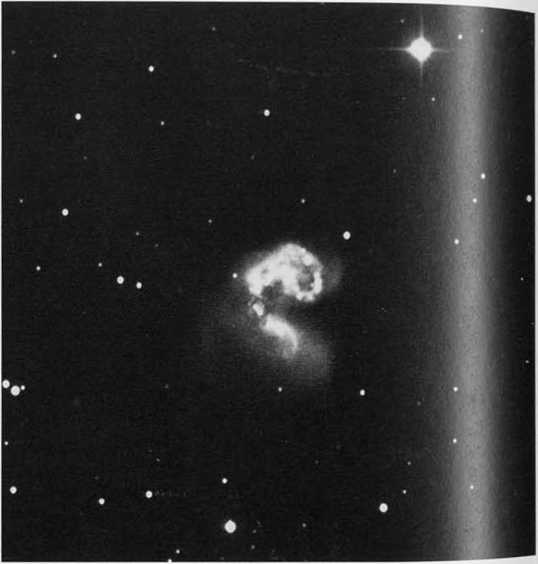
NGC 4038, with its companion NGC 4039, is popularly known as the Ring-tail Galaxy or the Antennae (Figure 6.13). Located along the western edge of Corvus, it is listed as a peculiar galaxy, and that alone makes it a tempting target for amateur and professional astronomers alike. The unusual shape is believed to result from the collision of two galaxies, a theory borne out by computer simulations. Though Burnham devotes considerable space to this object m his Celestial Handbook, the visual observer will see only an asymmetrical blur, about 21/?' in diameter and 11 th magnitude. NGC 4038-39 is shaped like an apostrophe in my old 10-inch reflector. Photographs made with large telescopes show two separate central masses each with a long curving tail. This is a unique sigh* vvould be a good target at a star party, where it could be viewed in several different telescopes.
° Several times amateurs have sent descriptions of what they believe is this , but I’m sure they have mistaken another galaxy for the Ring-tail. My 5-7 . 20x Apogee refractor shows the pair as a bright blob. An observation made ,n h’ mv 4-inch Clark refractor under the indifferent skies of my old home in Haddam. Connecticut, revealed NGC 4038-39 to be little more than an asym-trical 1 lth-magnitude blur. However, at a campsite near Big Sur, California, I °iewed a wealth of detail in the Ring-tail with a borrowed 12-inch reflector. Other reports in my files support this. At Omaha. Nebraska, Frank Rolwicz’s 10-inch Newtonian easily showed the galaxy’s “tail.” And viewing with a 10-inch reflector. Morales thought that the galaxies looked like a shrimp.
What they remind me of, however, is heavily inspired by my interests while in 2rade school. Even before I discovered telescopes, I was crazy about microscopes. 1 would talk my science teacher into letting me borrow the school’s microscope on holidays and weekends, and would bicycle to lakes and ponds near my home in Wisconsin to examine water samples. One creature I found in abundance was the water flea, Daphnia. There was a time when I could instantly identify a dozen species with just a glance in the microscope. So it’s understandable why I associated NGC 4038-39’s photographic appearance with the grandmother of all water fleas.
About 40' southwest of the Ring-tail is a galaxy of similar size, NGC 4027. I make its visual magnitude to be 11.3, about half a magnitude fainter than NGC 4038. Most telescopes will show both objects in the same low-power field.This spiral is about 2' in diameter and I have seen it in my 4-inch and in the Moonwatch 5-inch Apogee telescope. The background is so uncluttered in this area that faint nebulae are definitely easier to identify than in most other parts of the sky.
A pair of small galaxies in eastern Corvus is probably too faint for a 4-inch telescope, but should be within the grasp of an 8-inch. NGC 4782 and 4783 are almost touching each other. These twin elliptical galaxies are 0.5' across with photographic magnitudes of 12.9, but are a bit brighter visually. They lie about 14° due north of an 8th-magnitude star, and I suggest searching for them with a magnification of about lOOx.
■Bvo more galaxies are nearby. They are very faint, and I suspect they require at least a 12-inch telescope. Some 9' east of the last pair. NGC 4794 is about 14th magnitude and slightly brighter than NGC 4792 to its northwest. Experienced astrophotographers might find these galaxies a challenge. If so, I am sure your results will be worth the effort.
Before leaving the Corvus region, try examining M104, just over the northern fder in Virgo. Recall the earlier discussion of Messier’s original catalog of star asters and nebulae, published in Connaissance des temps. It had a total of 103 ^tr'es, but Messier’s personal notes made it clear that he knew of other objects.
r°ugh the efforts of 20th-century astronomers who studied the catalog in eta>l, these objects have been included as entries 104 to 110.
It was the French science popularizer Camille Flammarion who got the I rolling when, in 1921, he proposed that NGC 4594 be included as M104 beca Messier had penned a reference to the "nebula" in his own working copy Of l 6 catalog. Is
Figure 6.14 The Sombrero is one of the most easily recognized extragalactic deep-sky treasures. It lies about 65 million light-years away and is part of the great Virgo Cluster of Galaxies.
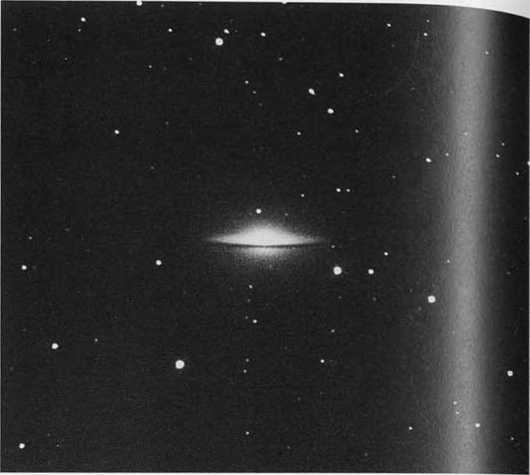
Often called the Sombrero Galaxy, M104 is an easy object for even the smallest telescope (Figure 6.14). Its bright, 8th-magnitude oval disk is about 8' long and well within the reach of binoculars. The nearly edge-on galaxy is noted for a dark band slicing across its middle. In their Observing Handbook and Catalogue of Deep-Sky Objects, Christian Luginbuhl and Brian Skiff note that "the dark lane can be seen easily" in a 6-inch telescope. On the other hand, John Mallas. the skilled deep-sky observer and coauthor of The Messier Album, could not see the lane with a 4-inch refractor.
But on one excellent night back home in Connecticut I saw the lane with a 4-inch Byrne refractor and a 4-inch off-axis reflector. To my surprise the lane was more difficult in the refractor, even though refractors usually scatter less light than reflectors. Scattered light degrades the view by reducing image contrast. When I placed a dark cloth over my head to block light entering my eye front the side, M104’s dark lane was definitely easier to see.
Sometimes it’s easy to forget just how much the atmospheric debris, which becomes more concentrated as we look near the horizon, affects our view of the sky. This is true whether we use the naked eye or a telescope. For me. many ol these southern objects would have much less appeal were it not for my occasional excursions into Central America, where they stand 20° higher than at home. I suspect that whenever eclipse chasers travel to southern locations, they find viewing the night sky just as rewarding as the solar three-ring circus itself-
JUNE OBJECTS
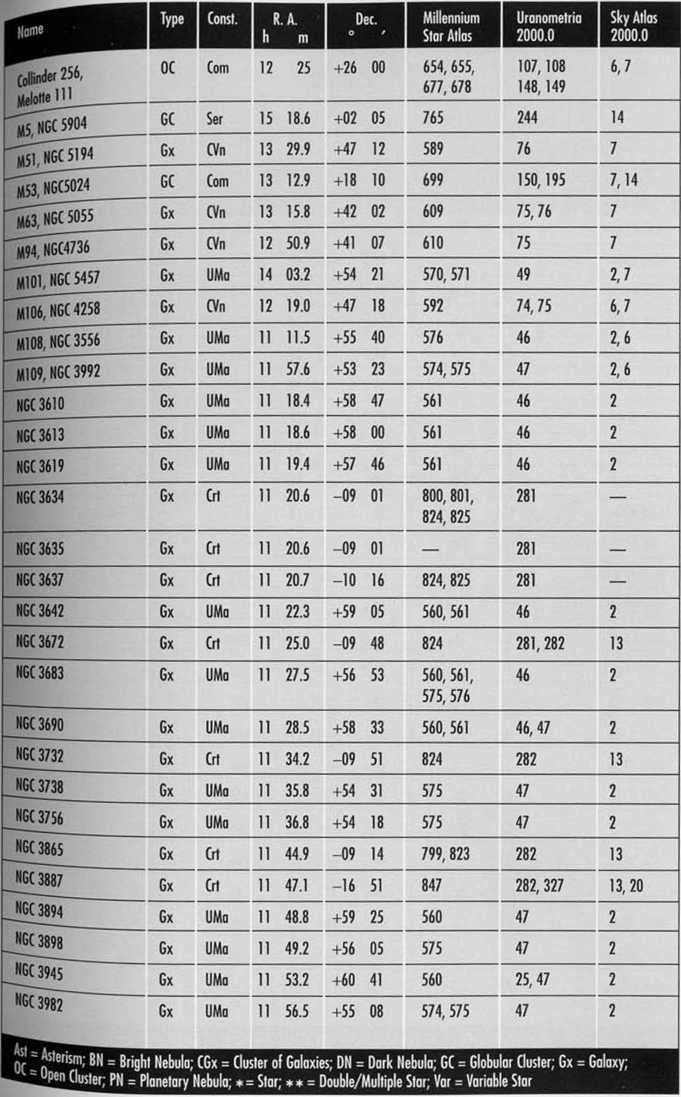

|
Name |
Type |
Const. |
R. A. h m |
Det. o / |
Millennium Star Atlas |
Uranometria 2000.0 |
SkyAtla^ 2000.0 |
|
NGC4027 |
Gx |
Crv |
11 59.5 |
-19 16 |
846, 847 |
327, 328 |
13,21 |
|
NGC4036 |
Gx |
UMa |
12 01.4 |
+61 54 |
559, 560 |
25,47 |
2 """ |
|
NGC4041 |
Gx |
UMa |
12 02.2 |
+62 08 |
559 560 |
25 |
2 ~~ |
|
NGC4147 |
GC |
Com |
12 10.1 |
+18 33 |
702 |
148 |
~T14 ' |
|
NGC41 S3 |
Gx |
Com |
12 10.8 |
+18 22 |
— |
— |
— |
|
NGC4217 |
Gx |
CVn |
12 15.8 |
+47 06 |
592 |
74 |
2,6 " |
|
NGC4361 |
PN |
Crv |
12 24.5 |
-18 48 |
845 |
328 |
13,21 |
|
NGC4605 |
Gx |
UMa |
12 40.0 |
+61 37 |
558 |
25,48 |
2 |
|
NGC 4782 |
Gx |
Gv |
12 54.6 |
-12 34 |
820 |
284 |
14 |
|
NGC 4783 |
Gx |
Crv |
12 54.6 |
-12 33 |
820 |
284 |
14 |
|
NGC 4792 |
Gx |
Crv |
12 55.1 |
-12 30 |
820 |
284 |
— |
|
NGC4794 |
Gx |
Crv |
12 55.2 |
-12 37 |
820 |
284 |
— |
|
NGC4814 |
Gx |
UMa |
12 55.4 |
+58 21 |
558 |
48 |
2 |
|
NGC4868 |
Gx |
CVn |
12 59.1 |
+37 19 |
631 |
108,109 |
7 |
|
NGC 4914 |
Gx |
CVn |
13 00.7 |
+37 19 |
631 |
108,109 |
7 |
|
NGC 5005 |
Gx |
CVn |
13 10.9 |
+37 03 |
630 |
109 |
7 |
|
NGC5033 |
Gx |
CVn |
13 13.4 |
+36 36 |
630 |
109 |
7 |
|
NGC 5053 |
GC |
Com |
13 16.4 |
+17 42 |
699 |
150,195 |
7,14 |
|
NGC5195 |
Gx |
CVn |
13 30.0 |
+47 16 |
589 |
76 |
7 |
|
NGC5198 |
Gx |
CVn |
13 30.2 |
+46 40 |
589 |
76 |
7 |
|
NGC5350 |
Gx |
CVn |
13 53.4 |
+40 22 |
608 |
76 |
7 |
|
NGC5353 |
Gx |
CVn |
13 53.5 |
+40 17 |
608 |
76 |
7 |
|
NGC 5354 |
Gx |
CVn |
13 53.5 |
+40 18 |
608 |
76 |
7 |
|
NGC 5371 |
Gx |
CVn |
13 55.7 |
+40 28 |
608 |
76 |
7 |
|
NGC 5740 |
Gx |
Vir |
14 44.4 |
+01 41 |
766 |
243 |
14 _____. |
|
NGC 5746 |
Gx |
Vir |
14 44.9 |
+01 57 |
766 |
243 |
M - |
|
NGC 5846 |
Gx |
Vir |
15 06.4 |
+01 36 |
765 |
243 |
14__ |
|
NGC 5850 |
Gx |
Vir |
15 07.1 |
+01 33 |
765 |
243 |
14__ |
|
NGC 5866 |
Gx |
Dra |
15 06.5 |
+55 46 |
568 |
50 |
2,7_____ |
|
Owl Nebula, M97, NGC 3587 |
PN |
UMa |
11 14.8 |
+55 01 |
576 |
46 |
2,6 |
Ast = Asterism; BN = Bright Nebula; CGx = Cluster of Galaxies; DN = Dark Nebulo; GC = Globular Cluster; Gx = Goloxy; OC = Open Cluster; PN = Planetary Nebulo; » = Star; * * = Double/Multiple Star; Var = Variable Star
|
Nome |
Type |
Const. |
R. A. h m |
Dec. o / |
Millennium Star Atlas |
Uronomefrio 2000.0 |
Sky Alios 2000.0 |
|
King-foil Goloxy, NGC4038-39 |
Gx |
Crv |
12 01.9 |
-18 52 |
846 |
327,328 |
13,21 |
|
Sombrero Goloxy, M104, NGC 4594 |
Gx |
Vir |
12 40.0 |
-11 37 |
820, 821 |
284 |
14 |
|
. . Asterism; BN = Bright Nebulo; CGx = Cluster of Goloxies; DN = Dork Nebulo; GC = Globular Cluster; Gx = G nC = Open Cluster; PN = Planetary Nebulo; * = Star; ** = Double/Multiple Sfor; Vor = Vorioble Star |
alaxy; | ||||||
